VGC News/Newsletters - Lakes Gliding Club
VGC News/Newsletters - Lakes Gliding Club
VGC News/Newsletters - Lakes Gliding Club
Create successful ePaper yourself
Turn your PDF publications into a flip-book with our unique Google optimized e-Paper software.
In 1932 the Akaflieg stm·ted the development of che 0 28,<br />
the subject of this article. The aim was to get good performance<br />
even in poor weather conditions by building a relatively<br />
small plane to the lowest possible weight. Iln this respect<br />
the D 28 is unique stiB to this day; the empty weight was 54<br />
kg (119 lb.) with a wing span of 12 m.<br />
The main technical data:<br />
Span 12,0 m<br />
Wing Area 11,4 m2<br />
Wing Aspect Ratio 12,6<br />
Wing Profile<br />
Gottingen 535 modified<br />
Empty Weight 54 kg<br />
Wing 27 kg<br />
Fuselage 17 kg<br />
Empennage 6 kg<br />
Instruments 4 kg<br />
Payload 75 kg<br />
Maxil11l!Jm Weight 129 kg<br />
Wing loading 11,3 kg/m2<br />
LID (Measured at DFS 23,5 at 60,5 km/h<br />
by Hans Zacher and R. Kreyser)<br />
Minimum Sink 0,66 m/s at 52,0 km/h<br />
Minimum Airspeed 43 km/h<br />
dJ-- --;<br />
Figure 2 : Rudder/Aileron Coupling Gear<br />
~___ 5910-- - J<br />
Figure 3: Semi-damped Fin and Rudder<br />
Figure 1 : D 28 "Windspiel"<br />
The main student designers were R. Schomerus and R.<br />
Kosin. Rlidiger Kosin later played an important role as chief<br />
aerodynamicist for the first jet bomber ARADO 234.<br />
The one-piece wi1ng had one spar and a plywood torsion<br />
nose box. The wing was attached to the fuselage by three duralumin<br />
fittings. The full-span ailerons were operated in<br />
common mode for airt{jil camber control and in opposite<br />
mode for roll control. Rudder and ailerons were coupled by a<br />
special gear, so with increasing rudder deflection the differential<br />
function of the aileron was increased. This gear is shown<br />
in the Figure 2. The fin and rudder arrangement of the D 28<br />
was "semi-damped". The fin moved together with the rudder,<br />
but only with 1f3 of the rudder deflection.<br />
These special details were unique; they were never used on<br />
other airplanes except the Darmstadt 0 30, which also had the<br />
semi-damped fin and rudder arrangement. Personal comment<br />
of Hans Zacher: "The manoeuvrability of the 0 28 at the low<br />
speed of 60 krn/h was really exceptional due to the semidamped<br />
rudder and the variable differential function of the<br />
aileron. The LID of 23,S was remarkable compared to the DFS<br />
Meise with 15 m span, a design which occured five years later.<br />
I liked to fly the D 28 and moved it lively around the three<br />
axes".<br />
The front fuselage was a conventional wood structure; the<br />
rear fuselage was a plywood tube over frames without<br />
stringers.<br />
The small weight was achieved by extremely careful<br />
design and construction and exceptional skill in the workshop.<br />
The D 28 was completely designed to the pre-war German<br />
sailplane airworthiness specifications BFS and was even certified<br />
for simple aerobatics. The following measures contributed<br />
to the low weight:<br />
16

















